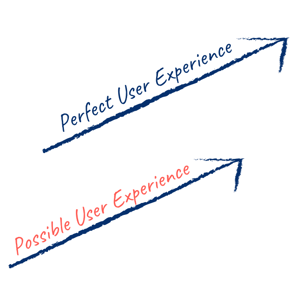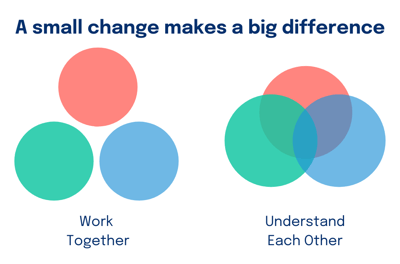Empathy is at the core of customer-centricity, a business philosophy that aims to create immediate customer value by responding directly to people’s needs. The ability to step into the mindset of another person so you can understand that person’s perspective, motivation, and feelings is more than just a great skill to cultivate in your personal life. It not only helps guide successful personal interactions; in customer-centric organizations, it is a key driver of business decision-making.
 Jeff Bezos famously described consumers as “divinely discontent," acknowledging that people’s expectations and opinions are constantly changing. That means that what companies consider to be the best possible customer experience must similarly be constantly changing. Companies like Amazon recognize that they must be agile, perpetually moving along with their customers. The goal cannot be to create a single perfect customer experience but rather to deliver and continue to grow the possible customer experiences alongside their expectations.
Jeff Bezos famously described consumers as “divinely discontent," acknowledging that people’s expectations and opinions are constantly changing. That means that what companies consider to be the best possible customer experience must similarly be constantly changing. Companies like Amazon recognize that they must be agile, perpetually moving along with their customers. The goal cannot be to create a single perfect customer experience but rather to deliver and continue to grow the possible customer experiences alongside their expectations.
-1.png?width=300&name=to%20understand%20customers%20(2)-1.png) This means that efforts to build empathy must be active at all times due to the constantly shifting expectations of consumers. The COVID-19 pandemic has revealed how dramatically and rapidly people’s attitudes and behaviors can change. Companies that have adopted - or can readily embrace - customer-centric product development processes are uniquely positioned to be successful during this time. These companies are designed to be agile and rapidly adapt to change. In order to sustain always-on empathy, many companies are using agile research methodologies and tools. Agile research is used to inform the agile decision-making required to continuously align products and services to customers’ needs and wants.
This means that efforts to build empathy must be active at all times due to the constantly shifting expectations of consumers. The COVID-19 pandemic has revealed how dramatically and rapidly people’s attitudes and behaviors can change. Companies that have adopted - or can readily embrace - customer-centric product development processes are uniquely positioned to be successful during this time. These companies are designed to be agile and rapidly adapt to change. In order to sustain always-on empathy, many companies are using agile research methodologies and tools. Agile research is used to inform the agile decision-making required to continuously align products and services to customers’ needs and wants.
Effective agile research strategies cannot develop in a vacuum. There is a need for close collaboration between product teams and research teams to build and deploy agile research tools. Product managers and researchers have complementary approaches to empathy aligned to their roles.
Both product and research teams are deeply invested in building empathy with their customers. Product teams build empathy so they can design products that people want and need. Researchers are increasingly focused on measuring and reporting on people’s opinions, behaviors, and preferences in service of getting closer to the customer and building ongoing empathy throughout the organization. This data is used to keep products, messages, and missions aligned to target markets and continually shifting customer desires. However, the traditional focus of market research often does not account for the rapid, iterative development process involved in creating digital products.
Consider the following analogy to distinguish between agile research and traditional market research and corresponding decisions that they inform. When driving a car, you need to see out of the windshield to make sure you’re obeying stop signs, avoiding cyclists, and otherwise getting inputs so you can make the snap judgments that keep you safe and on track. What your eyes (and a clear windshield) can’t provide, however, is the right route to take to get to your destination. For that, you’ll need a map or GPS. Both the fast inputs of eyesight and the strategic inputs of a route are needed to get you where you need to go.

To continue the metaphor, product managers can’t do their jobs without immediate data--eyesight, in our metaphor above. To compete in ever-changing markets, this data is crucial to their day-to-day jobs. Traditional market research, however, is often focused on uncovering the data equivalent to maps and GPS.
This difference in focus means that product and research teams don’t always take the time to build empathy between one another. The professionals in these two disciplines can think differently because of the different ways they approach solving business problems and a misalignment of objectives. Business teams are focused on the shared goal of revenue growth, whereas researchers focus on getting a holistic understanding of the market or even a deep understanding of customers, but not necessarily on day-to-day KPIs. Product managers must make quick, directional decisions as they build. Researchers are often charged with taking a methodical, careful approach to designing studies that will get them the data their stakeholders need. The operating rhythms of these two groups are frequently out of sync and need to be realigned if research is to inform the rapid decision making that makes so many companies successful. It’s a new world for research teams, but product teams must also be aware that research without rigor creates a false sense of confidence. Awareness of these differences is the first step towards inter-team empathy, effective collaboration, and agile problem-solving.

There is a huge gap between customer-centricity in theory and in practice, and building a shared understanding between product and research teams is crucial to -1.png?width=177&name=to%20understand%20customers%20(1)-1.png) closing this gap. In theory, companies can spend endless time studying and learning from their target customers. In reality, those customers are constantly changing which means the market is always moving. That means the understanding of these customers will always be imperfect. Furthermore, competitors are taking actions that, while imprecise, are having an impact and chipping away at market share. The fact is that companies that do not actively work to get ahead are continually falling behind.
closing this gap. In theory, companies can spend endless time studying and learning from their target customers. In reality, those customers are constantly changing which means the market is always moving. That means the understanding of these customers will always be imperfect. Furthermore, competitors are taking actions that, while imprecise, are having an impact and chipping away at market share. The fact is that companies that do not actively work to get ahead are continually falling behind.
Agile problem-solving is more crucial than ever, because the speed of change has accelerated at a never-before-seen rate. What began with rapid advancements in technology and changing generational preferences has been intensified by the COVID-19 pandemic. Being customer-centric is no longer merely a nice to have. Without always-on empathy, companies will fail to stay aligned with their customers. Every company must become agile in order to be resilient in the face of rapidly changing consumer expectations.
For product teams, agility means taking an iterative approach to development. Aggregating a series of incremental changes, each of which is aligned to customer sentiment, means shipping products that will continue to delight.
For many researchers, agility is a newly learned skill that is making them think outside of their traditional toolkit. These professionals are responsible for highly methodical work focused on getting data in the right resolution while maximizing impact, and agile research is providing them with a way to do exactly that, faster than ever before. The intersection of agility and consumer data has never been more important, so it’s time to build the feedback loop between these crucial teams.


.png?width=352&name=Where%2c%20why%20and%20when%20(1).png)

